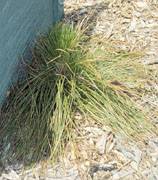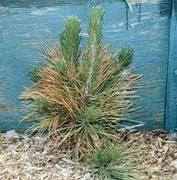
Longleaf Pine (grass stage)

Apache Pine (grass stage)

Mexican Red Pine
"I honestly believe it iz better tew know nothing than tew know what ain't
so."
-- Josh Billings, Directory of Proverbial Philosophy
Zonal Denial
|
|
|
| Pearson Creek Unit | ||
"The man who always fights one more round is never whipped." -- James J. Corbett
Sometime in the Spring of 1997, the morning show of public radio had an interview with a garden club spokes-person from Anchorage Alaska. A common behavior among gardeners in Anchorage (which is in hardiness zone 4) is, according to this interviewee, is Zonal Denial which was defined in attempts to grow plants which are normally limited to milder winter hardiness zones.
This practice has been carried on at The Lovett Pinetum for about 25 years. The summary of this experience is that Zonal Denial is a very very tough game, with a staggeringly high ratio of losers to winners. The logical idea is that if a given species from a significantly milder hardiness zone can be made to survive one, two or three winters, it will have adapted ("hardened") and thus be able to survive indefinitely. This is especially appealing to reason when there are a few surviving individuals out of a large planting. You would think that you have let nature select the hardiest individuals, perhaps those at the far end of the Gausian normal distribution (bell-shaped) curve which had a naturally superior defense against the cold.
This kind of thinking and behavior leads to repeated disappointments. The empirical lesson at the Lovett Pinetum is that previous winter survival by inappropriately high zone pines usually doesn't favor these individuals for the next winter. In fact, the general experience seems closer to the opposite, that is, there seems to be a cumulative winter effect for surviving high zone individuals. They can survive one or two tough winters, but are progressively weakened and might fail during a milder third winter.
The latest USDA Hardiness Zone map (1994 Taylor Master Guide to Gardening, p.576-7) shows the Lovett Pinetum in upper zone 6, a few miles south of the zone 5 border with zone 6. The 3 winters ('93-4 to '96-7) prior to last year's ('97-8) very mild winter had definitely been zone 5 (-10 to-20 degrees F.). There is rarely snow on the ground which usually freezes down to 3 -6 inches.
Rarely there are pleasant surprises, which actually probably means the hardiness zone number assigned to such a species is incorrect or that their geographic limits are not defined by resistance to cold. And this seems more likely when one observes the wide range of hardiness zone numbers assigned by different sources to some pine species. As Gerd Krussman stated in his book, the difficulty lies with the fact that the hardiness of a particular plant or species is variable and never absolute.
So what are some of the surprises? Well, first off, there are several zone 7 successes, such as Pinus taeda, echinata, pungens, virginiana, attenuata, monticola -- not too surprising. A really pleasant surprise is encounter winter hardiness in a zone 8 or more species. Keeping in mind the cumulative winter theory and thus knowing that success with Zonal Denial is never final, here are a few apparent successes with zone 8 or above: